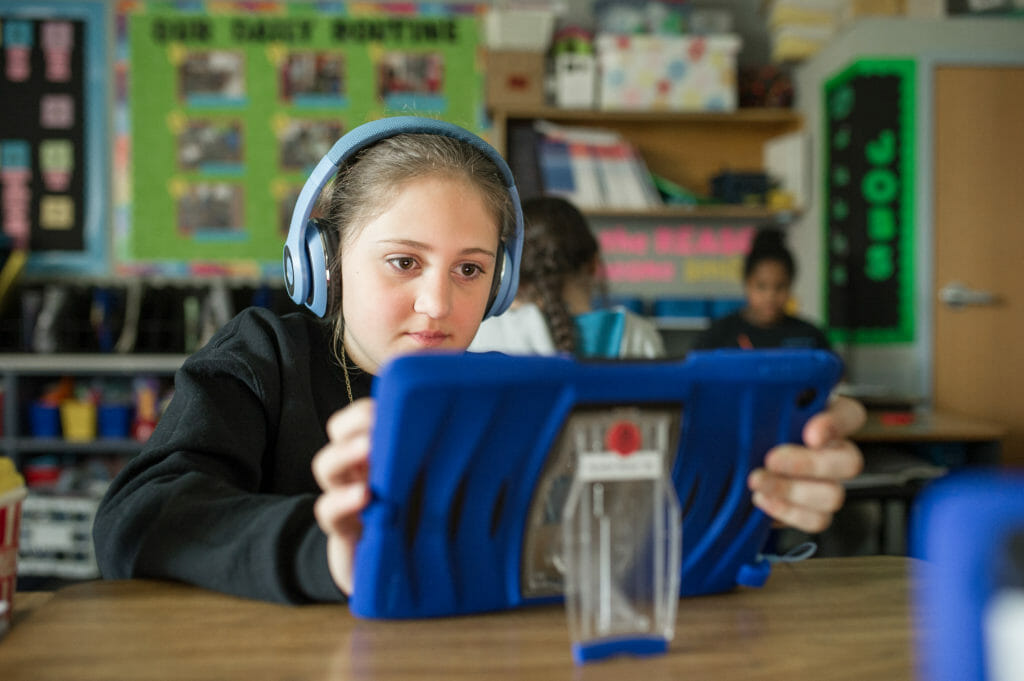Hope Tucker, Middle School Reading Specialist
Dyslexia in Middle School

Research has shown that learning to read does not happen naturally. It’s a very deliberate and sequential process that must be explicitly taught. Much like building a house, independent reading requires a strong foundation upon which layers are added to and combined with higher level comprehension skills. In the case of reading, those foundations begin with phonological awareness–being able to identify and manipulate sounds in words. When it comes to supporting students with dyslexia, early intervention is key. Unfortunately, the reality is that not everyone receives remediation right off the bat. In fact, many students make it all the way to Middle School before getting a definitive diagnosis, or receiving the help they need and deserve.
Here’s the good news: it is not too late for Middle School students with dyslexia to learn effective reading skills and strategies to help them become active, independent readers. At McLean School, regardless of the age and stage of our students, we use evidence-based best practices for teaching foundational reading skills. Specifically, we utilize Orton-Gillingham (OG) methodologies which are explicit, direct, sequential, systematic, and multi-sensory, to teach reading. This type of instruction is essential for teaching students with dyslexia.
Many of our Middle School Literature and English teachers have OG training and experience. We also teach our students how to use available assistive technologies. Much like science or math, there’s an order of operations when it comes to reading–each skill builds on the one that comes before it. Students with dyslexia who reach Middle School without early interventions are likely to lack this essential skill building and instead have come to rely heavily on context clues–which is not a sustainable strategy. So we circle back to the building blocks and provide explicit instruction in a few ways:
- Classroom instruction. In grades 5 and 6, our teachers explicitly teach encoding and decoding strategies using Orton-Gillingham and Wilson reading methodologies. Active reading strategies are specifically taught and we always model what good readers do when reading.
- Small group work. As the Reading Specialist, I see up to 30 students, twice each week in small groups of 4-5 students. In our small groups we work on encoding, decoding, morphology, and comprehension strategies.
- Push-in. I also work alongside the teacher in a grade 5 English and Literature class, and provide Orton-Gillingham instruction in a grade 7 and a grade 8 Literature class as dictated by student needs.
In addition, important accommodations are introduced which are designed to help build independence and confidence around reading, including:
- Read & Write. A Google Chrome extension is installed on each Chromebook and provides comprehensive reading and writing supports.
- Text-to-speech. Helps students access higher-level material that they’re intellectually capable of understanding. All of our students have access to Learning Ally audiobook solutions, as well.
- Speech-to-text. Enables students to showcase a more developed vocabulary and mastery of sentence structure without the trappings that come with spelling struggles.
- Faculty readers and scribes. Allows a student, during a test, to focus less on decoding the questions and more on giving thoughtful, accurate answers.
- Additional accommodations. Additional time, modified test formats, larger text, and the ability to use a special typeface specifically designed to make reading and learning easier and more accessible for those with dyslexia.
A substantial part of our program here at McLean is helping our students learn to advocate for themselves. I would love it if all of my students were able to do this effortlessly, and many can, but it’s a big ask of Middle Schoolers, especially those new to McLean. So we do all we can to normalize the struggles and help our students feel comfortable accepting and talking about what’s hard for them. In time, as students begin to notice and hear their peers speak out about their challenges, and get recognized for it–“the print on this page is too small, can you blow it up for me?”–they learn to solicit the specific help they need. Until then, a teacher might discreetly lean in and ask, “Would you like me to make this print bigger?”
While our Middle School students are well aware of their challenges, we want them to be mindful of and celebrate their strengths. Therefore, our teachers incorporate our Abilities Model®, which highlights students’ strengths and helps them learn the way they learn best. Many of my students are quite gifted in their grasp of oral language and are able to carry on deep and thoughtful discussions. Students with dyslexia are often amazing artists, and I have some who have linked their study of syllables with imagery in ways that advance their learning. Others have incredible spatial reasoning skills, which might make geometry come more easily, or perhaps they can identify and draw diagrams in amazing detail. By Middle School, many of my students with dyslexia have tapped into many of their strengths, which is really wonderful to see, and tempers the negative beliefs students may have about themselves as learners.
There’s no “cure” for dyslexia–it is a lifelong challenge. But that doesn’t mean a student can’t be successful, and even learn to love reading. In my 20 years here at McLean, I’ve seen it time and again, and not just with those who have been able to get the help they need in those earliest elementary years. The right setting together with strategic interventions, effective technology tools, and dedicated, trained, expert educators can help even the most challenged Middle School readers with dyslexia make great progress.